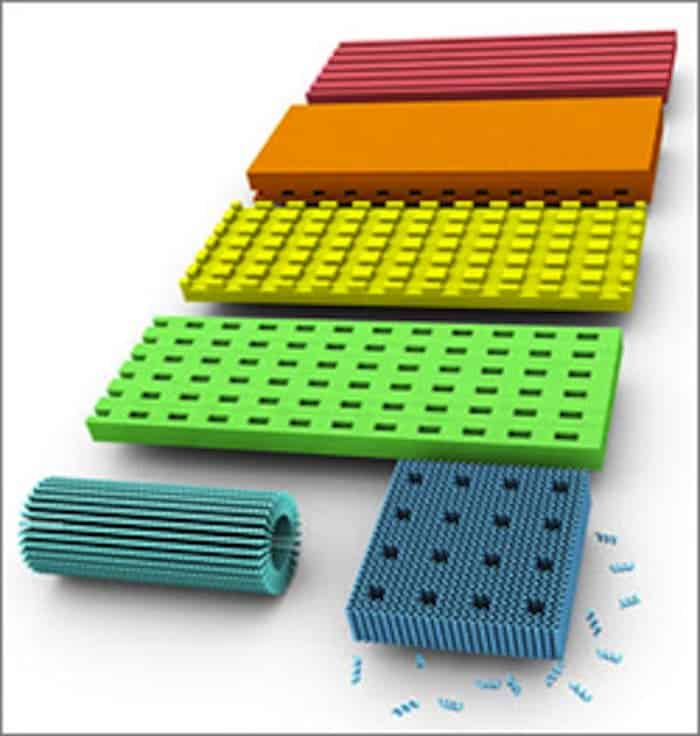A team at Harvard’s Wyss Institute for Biologically Inspired Engineering demonstrated the latest advances in programmable DNA self-assembly by crystallizing 32 structures with precisely prescribed depths and complex 3D features. The DNA crystals could potentially be used as the basis of a programmable material platform that would allow scientists to build extremely precise and complex structures rivaling the complexity of many molecular machines we see in nature – all from the bottom up!
Nanotechnology like Lego

For the past twenty years or so, there’s been a lot of interest shown into designing large DNA crystals of various desired shapes by exploiting DNA’s inherent ability to self-assemble. We’re recently beginning to see the fruits of this labor, first in 2012 when the same team described their “DNA-brick self-assembly” method that allowed them to build more than 100 3D complex nanostructures about the size of viruses. The 32 designs reported in this latest research are 1000 times larger, close to the size of a speck of dust, which makes them closer to applicable scale where they can be used practically.
“We are very pleased that our DNA brick approach has solved this challenge,” said senior author and Wyss Institute Core Faculty member Peng Yin, Ph.D., who is also an Associate Professor of Systems Biology at Harvard Medical School, “and we were actually surprised by how well it works.”
[ALSO READ] Synthetic ‘living’ crystals might offer insights onto origins of life
With conventional methods of DNA assembly, the resulting design tends to become more and more imperfect as you scale the design because at each step there’s a risk of error. The technique developed at Harvard is different because since it uses short, synthetic strands of DNA that work like interlocking Lego® bricks to build complex structures – it’s a modular design. Each structure first starts off as a computer model of a molecular cube (the master canvas), then individual DNA bricks are removed or added independently until a desired shape is met. These bricks bind to as many as four neighboring strands or bricks. Thus, two bricks connect to one another at a 90-degree angle to form a 3D shape, just like a pair of two-stud Lego bricks. Each individual brick is coded in such a way that they self-assemble in a desired 3-D shape. What’s fantastic is that this method allows for intricate shapes to built on an extremely tiny scale opening up a slew of applications. For instance, a cube built up from 1,000 such bricks (10 by 10 by 10) measures just 25 nanometers in width – thousands of times smaller than the width of a human hair!
“Therein lies the key distinguishing feature of our design strategy—its modularity,” said co-lead author Yonggang Ke, Ph.D., formerly a Wyss Institute Postdoctoral Fellow and now an assistant professor at the Georgia Institute of Technology and Emory University. “The ability to simply add or remove pieces from the master canvas makes it easy to create virtually any design.”
Precision controlled DNA
Most importantly, this modularity allows precision control of the structure’s depth. This is the first time that anyone has been able to design crystal depth with nanometer precision, up to 80 nm, as opposed to two-dimensional DNA lattices which are typically single-layer structures with only 2 nm depth.
“DNA crystals are attractive for nanotechnology applications because they are comprised of repeating structural units that provide an ideal template for scalable design features”, said co-lead author graduate student Luvena Ong.
To further demonstrate the grade of precision they can achieve with this method, the researchers placed gold nanoparticles into prescribed 2D architectures less than two nanometers apart from each other along the crystal structure. As chip technology advances, so does miniaturization and this kind of control will prove to be indispensable for future quantum devices. Similarly, very smart drugs can be made using DNA self-assembly.
“My preconceived notions of the limitations of DNA have been consistently shattered by our new advances in DNA nanotechnology,” said William Shih, Ph.D., who is co-author of the study and a Wyss Institute Founding Core Faculty member, as well as Associate Professor in the Department of Biological Chemistry and Molecular Pharmacology at Harvard Medical School and the Department of Cancer Biology at the Dana-Farber Cancer Institute. “DNA nanotechnology now makes it possible for us to assemble, in a programmable way, prescribed structures rivaling the complexity of many molecular machines we see in Nature.”
“Peng’s team is using the DNA-brick self-assembly method to build the foundation for the new landscape of DNA nanotechnology at an impressive pace,” said Wyss Institute Founding Director Don Ingber, M.D., Ph.D. “What have been mere visions of how the DNA molecule could be used to advance everything from the semiconductor industry to biophysics are fast becoming realities.”
The crystalline DNA structures were described in a paper in Nature Chemistry.






